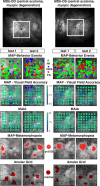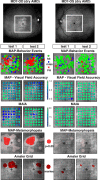Multi-line Adaptive Perimetry (MAP): A New Procedure for Quantifying Visual Field Integrity for Rapid Assessment of Macular Diseases
- PMID: 30356944
- PMCID: PMC6192464
- DOI: 10.1167/tvst.7.5.28
Multi-line Adaptive Perimetry (MAP): A New Procedure for Quantifying Visual Field Integrity for Rapid Assessment of Macular Diseases
Erratum in
-
Erratum.Transl Vis Sci Technol. 2018 Nov 14;7(6):4. doi: 10.1167/tvst.7.6.4. eCollection 2018 Nov. Transl Vis Sci Technol. 2018. PMID: 30479875 Free PMC article.
Abstract
Purpose: In order to monitor visual defects associated with macular degeneration (MD), we present a new psychophysical assessment called multiline adaptive perimetry (MAP) that measures visual field integrity by simultaneously estimating regions associated with perceptual distortions (metamorphopsia) and visual sensitivity loss (scotoma).
Methods: We first ran simulations of MAP with a computerized model of a human observer to determine optimal test design characteristics. In experiment 1, predictions of the model were assessed by simulating metamorphopsia with an eye-tracking device with 20 healthy vision participants. In experiment 2, eight patients (16 eyes) with macular disease completed two MAP assessments separated by about 12 weeks, while a subset (10 eyes) also completed repeated Macular Integrity Assessment (MAIA) microperimetry and Amsler grid exams.
Results: Results revealed strong repeatability of MAP and high accuracy, sensitivity, and specificity (0.89, 0.81, and 0.90, respectively) in classifying patient eyes with severe visual impairment. We also found a significant relationship in terms of the spatial patterns of performance across visual field loci derived from MAP and MAIA microperimetry. However, there was a lack of correspondence between MAP and subjective Amsler grid reports in isolating perceptually distorted regions.
Conclusions: These results highlight the validity and efficacy of MAP in producing quantitative maps of visual field disturbances, including simultaneous mapping of metamorphopsia and sensitivity impairment.
Translational relevance: Future work will be needed to assess applicability of this examination for potential early detection of MD symptoms and/or portable assessment on a home device or computer.
Keywords: macular disease; metamorphopsia; microperimetry; psychophysics; retina.
Figures






Similar articles
-
Entoptic perimetry screening for central diabetic scotomas and macular edema.Ophthalmology. 2000 Apr;107(4):755-9. doi: 10.1016/s0161-6420(99)00149-9. Ophthalmology. 2000. PMID: 10768339 Clinical Trial.
-
[Comparison of Preferential Hyperacuity Perimeter (PHP) test and Amsler grid test in the diagnosis of different stages of age-related macular degeneration].Klin Monbl Augenheilkd. 2006 Sep;223(9):752-6. doi: 10.1055/s-2006-926880. Klin Monbl Augenheilkd. 2006. PMID: 16986086 Clinical Trial. German.
-
Metamorphopsia in patients with macular telangiectasia type 2.Doc Ophthalmol. 2009 Oct;119(2):133-40. doi: 10.1007/s10633-009-9190-9. Epub 2009 Aug 27. Doc Ophthalmol. 2009. PMID: 19711108
-
Macular function surveillance revisited.Optometry. 2008 Jul;79(7):397-403. doi: 10.1016/j.optm.2007.09.017. Optometry. 2008. PMID: 18577497 Review.
-
Clinical Update on Metamorphopsia: Epidemiology, Diagnosis and Imaging.Curr Eye Res. 2021 Dec;46(12):1777-1791. doi: 10.1080/02713683.2021.1912779. Epub 2021 May 17. Curr Eye Res. 2021. PMID: 33825600 Review.
References
-
- Schiller JS, Lucas JW, Ward BW, Peregoy JA. Summary health statistics for U.S. adults: National Health Interview Survey, 2011. Vital Heal Stat. 2012;(256):1–218. - PubMed
-
- Friedman DS, O'Colmain BJ, Muñoz B, et al. Prevalence of age-related macular degeneration in the United States. Arch Ophthalmol. 2004;122:564–572. - PubMed
-
- Cruess AF, Zlateva G, Xu X, et al. Economic burden of bilateral neovascular age-related macular degeneration: multi-country observational study. Pharmacoeconomics. 2008;26:57–73. - PubMed
-
- Simunovic MP. Metamorphopsia and its quantification. Retina. 2015;35:1285–1291. - PubMed

